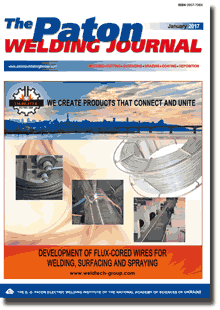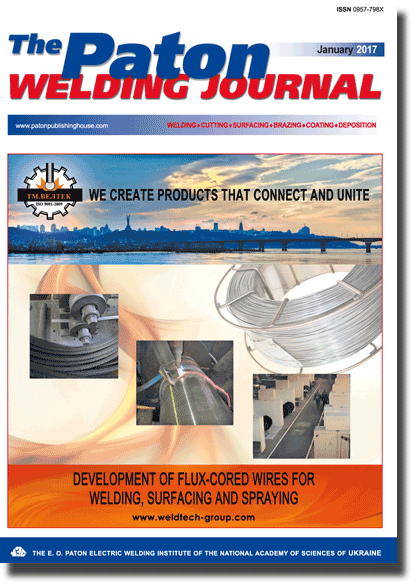Access for download PDF files for subscribers and for reviewers of scientometric bases.
Organization: Elsevier for content access(PDF files of journals released before 2024 are available for download from the website's archives))
Organization: Elsevier for content access(PDF files of journals released before 2024 are available for download from the website's archives))
| 2017 №01 (12) |
DOI of Article 10.15407/tpwj2017.01.13 |
2017 №01 (01) |

The Paton Welding Journal, 2017, #1, 10-13 pages
Computation and experimental evaluation of formation of primary structure in weld metal with refractory inoculants
D.Yu. Ermolenko and V.V. Golovko
E.O. Paton Electric Welding Institute, NASU 11 Kazimir Malevich Str., 03680, Kiev, Ukraine. E-mail: office@paton.kiev.ua
Abstract
Possibility of regulation of structure and properties of weld metal of high-strength low-alloy steels was considered. It can be done with the help of introduction in a weld pool of the disperse refractory inoculants as surface-active elements. A procedure was described for performance of the experiments on introduction of the different refractory inoculants (TiC, TiN, SiC, TiO2, Al2O3, Zr2O, MgO) in the weld pool in high-strength low-alloy steel welding. The results of investigation of effect of the introduced inoculants on primary structure parameters and main mechanical properties of investigated weld metal are given. A model of interaction of refractory inoculants with solidification front was briefly discussed. Parameters of primary weld metal structure with the refractory inoculants, which were received by means of experimental investigations and computation experiment, were compared. The results of this comparison showed adequacy of a proposed model of interaction of refractory inoculant with solidification front. 9 Ref., 2 Tables, 7 Figures.
Keywords: arc welding, high-strength low-alloy steels, dendrite structure, primary structure, disperse refractory inoculants, solidification
Received: 19.10.16
Published: 16.02.17
References
1. Golovko, V.V., Stepanyuk, S.N., Ermolenko, D.Yu. (2015) Effect of titanium-containing inoculants on structure and properties of weld metal of high-strength low-alloy steels. The Paton Welding J., 2, 14–18. https://doi.org/10.15407/tpwj2015.02.03
2. Golovko, V.V., Stepanyuk, S.N., Ermolenko, D.Yu. (2014) Technology of welding of high-strength low-alloy steels with introduction of titanium-containing inoculants. In: Collect. Monography: Nanosized systems and nanomaterials: Investigations in Ukraine. Ed. by A.G. Naumovets. Kiev: Akademperiodika.
3. Vanovsek, W., Bernhard, C., Fiedler, M. et al. (2013) Influence of aluminum content on the characterization of microstructure and inclusions in high-strength steel welds. Welding in the World, 57(Issue 1), 73–83. https://doi.org/10.1007/s40194-012-0008-0
4. (2011) Effects of soluble Ti and Zr content and austenite grain size on microstructure of simulated heat affected zone in Fe–C–Mn–Si alloy. ISIJ Int., 51(9), 1542–1533.
5. Ermolenko, D.Yu., Ignatenko, A.V., Golovko, V.V. (2016) Direct numerical modelling of formation of weld metal dendrite structure with disperse refractory inoculants, 12, 13–20.
6. Galenko, P.K., Krivilev, M.D. (2000) Isothermal growth of crystals in overcooled binary alloys. Matematicheskoe Modelirovanie, 12(11), 17–37.
7. ISO 26304:2011: Welding consumables. Solid wire electrodes, tubular cored electrodes and electrode-flux combinations for submerged arc welding of high strength steels. Classification.
8. Panasyuk, A.D., Fomenko, V.S., Glebova, G.G. (1986) Resistance of non-metallic materials in melts. Kiev: Naukova Dumka.
9. GOST 6996–66: Welded joints. Methods of determination of mechanical properties.
Suggested Citation
D.Yu. Ermolenko and V.V. Golovko (2017) Computation and experimental evaluation of formation of primary structure in weld metal with refractory inoculants. The Paton Welding J., 01, 10-13.The cost of subscription/purchase order journals or individual articles
| Journal/Currency | Annual Set | 1 issue printed |
1 issue |
one article |
| TPWJ/USD | 384 $ | 32 $ | 26 $ | 13 $ |
| TPWJ/EUR | 348 € | 29 € | 24 € | 12 € |
| TPWJ/UAH | 7200 UAH | 600 UAH | 600 UAH | 280 UAH |
| AS/UAH | 1800 UAH | 300 UAH | 300 UAH | 150 UAH |
| AS/USD | 192 $ | 32 $ | 26 $ | 13 $ |
| AS/EUR | 180 € | 30 € | 25 € | 12 € |
| SEM/UAH | 1200 UAH | 300 UAH | 300 UAH | 150 UAH |
| SEM/USD | 128 $ | 32 $ | 26 $ | 13 $ |
| SEM/EUR | 120 € | 30 € | 25 € | 12 € |
| TDNK/UAH | 1200 UAH | 300 UAH | 300 UAH | 150 UAH |
| TDNK/USD | 128 $ | 32 $ | 26 $ | 13 $ |
| TDNK/EUR | 120 € | 30 € | 25 € | 15 € |
AS = «Automatic Welding» - 6 issues per year;
TPWJ = «PATON WELDING JOURNAL» - 12 issues per year;
SEM = «Electrometallurgy Today» - 4 issues per year;
TDNK = «Technical Diagnostics and Non-Destructive Testing» - 4 issues per year.


